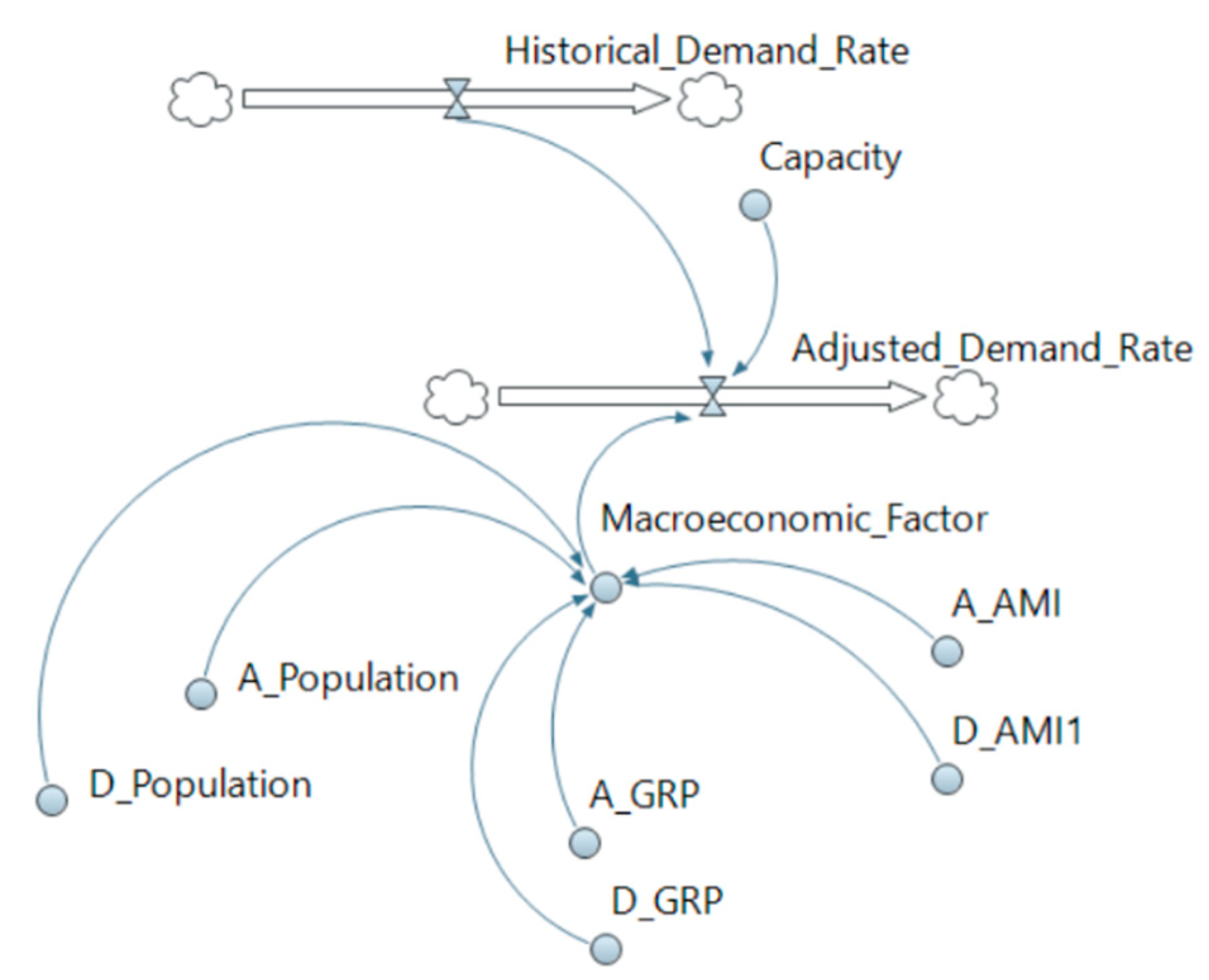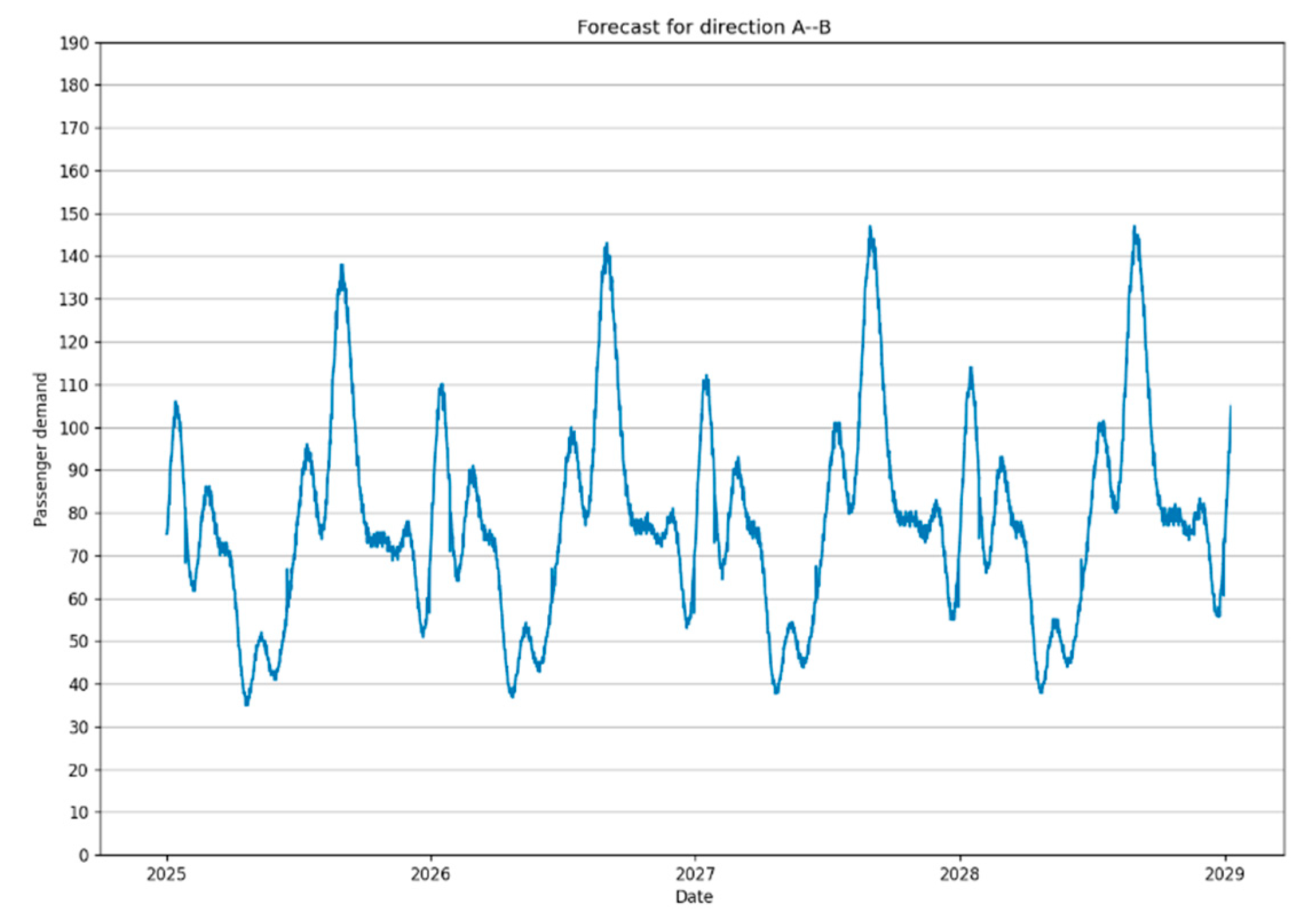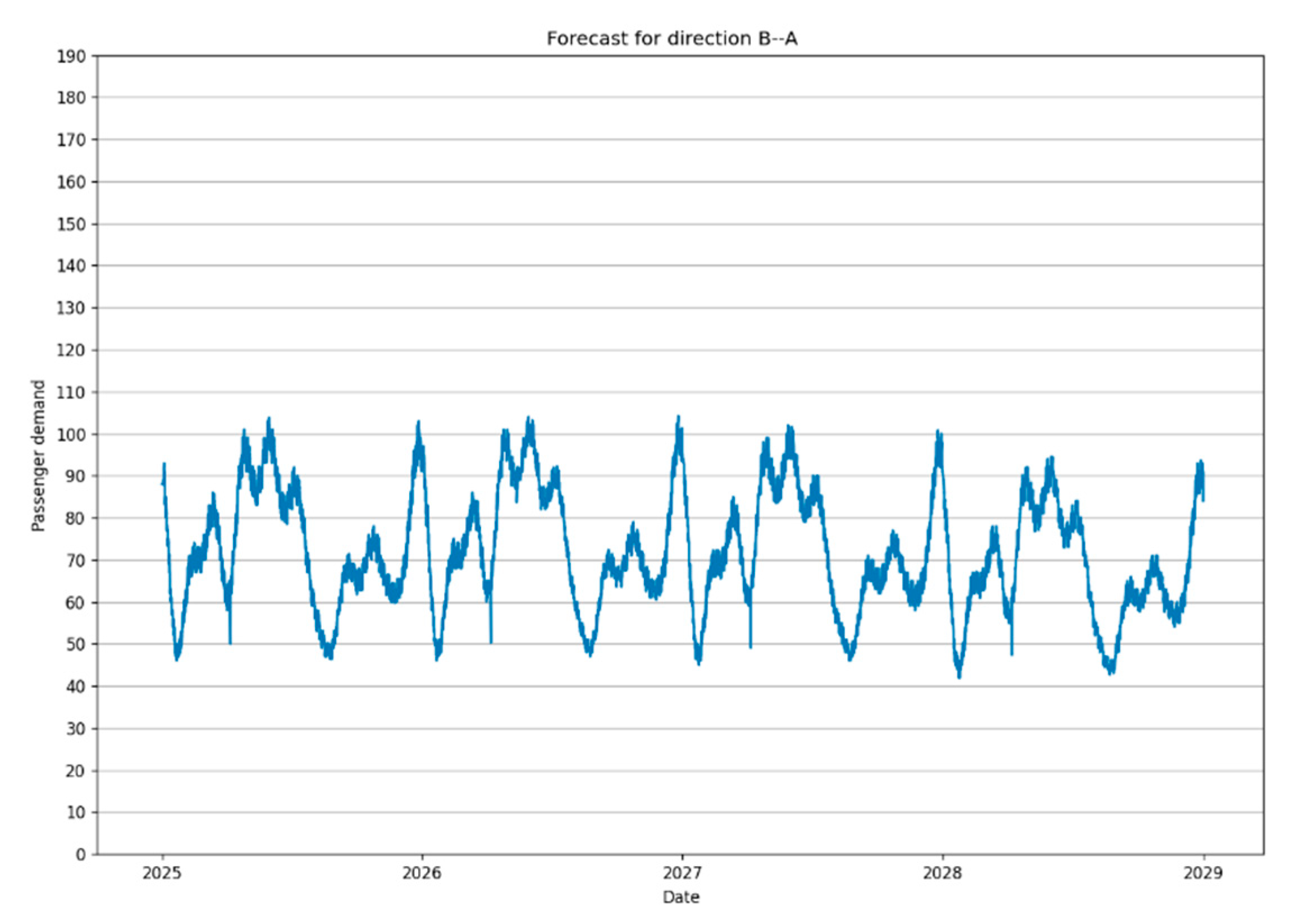Demand Forecasting Model for Airline Flights Based on Historical Passenger Flow Data
Abstract
:Featured Application
Abstract
1. Introduction
2. Materials and Methods
2.1. Description of a Typical Problem of Medium-Term Forecasting of Demand for Flights
2.2. Algorithm for Medium-Term Flight Demand Forecasting
3. Results
4. Discussion
5. Conclusions
Author Contributions
Funding
Institutional Review Board Statement
Informed Consent Statement
Data Availability Statement
Conflicts of Interest
References
- Bakreen, S.; Markovskaya, E.; Merzlikin, I.; Mottaeva, A. Development of the approach to the analysis of aviation industry’s adaptation to seasonal disruptions. Transp. Res. Procedia 2022, 63, 1431–1443. [Google Scholar] [CrossRef]
- Seymour, K.; Held, M.; Georges, G.; Boulouchos, K. Fuel Estimation in Air Transportation: Modeling global fuel consumption for commercial aviation. Transp. Res. Part D Transp. Environ. 2020, 88, 102528. [Google Scholar] [CrossRef]
- Yan, C.; Barnhart, C.; Vaze, V. Choice-based airline schedule design and fleet assignment: A decomposition approach. Transp. Sci. 2022, 56, 1410–1431. [Google Scholar] [CrossRef]
- Wei, K.; Vaze, V.; Jacquillat, A. Airline timetable development and fleet assignment incorporating passenger choice. Transp. Sci. 2020, 54, 139–163. [Google Scholar] [CrossRef]
- He, H.; Chen, L.; Wang, S. Flight short-term booking demand forecasting based on a long short-term memory network. Comput. Ind. Eng. 2023, 186, 109707. [Google Scholar] [CrossRef]
- Lin, L.; Liu, X.; Liu, X.; Zhang, T.; Cao, Y. A prediction model to forecast passenger flow based on flight arrangement in airport terminals. Energy Built Environ. 2023, 4, 680–688. [Google Scholar] [CrossRef]
- Güvercin, M.; Ferhatosmanoglu, N.; Gedik, B. Forecasting flight delays using clustered models based on airport networks. IEEE Trans. Intell. Transp. Syst. 2020, 22, 3179–3189. [Google Scholar] [CrossRef]
- van der Walt, A.; Bean, W.L. Inventory management for the in-flight catering industry: A case of uncertain demand and product substitutability. Comput. Ind. Eng. 2022, 165, 107914. [Google Scholar] [CrossRef]
- Wang, S.; Gao, Y. A literature review and citation analyses of air travel demand studies published between 2010 and 2020. J. Air Transp. Manag. 2021, 97, 102135. [Google Scholar] [CrossRef]
- Firat, M.; Yiltas-Kaplan, D.; Samli, R. Forecasting Air Travel Demand for Selected Destinations Using Machine Learning Methods. JUCS J. Univers. Comput. Sci. 2021, 27, 564–581. [Google Scholar] [CrossRef]
- Yirgu, K.W.; Kim, A.M. Airport choices and resulting catchments in the US Midwest. J. Transp. Geogr. 2024, 114, 103743. [Google Scholar] [CrossRef]
- Rodriguez, Y.; Pineda, W.; Olariaga, O.D. Air traffic forecast in post-liberalization context: A Dynamic Linear Models approach. Aviation 2020, 24, 10–19. [Google Scholar] [CrossRef]
- Li, X.; de Groot, M.; Bäck, T. Using forecasting to evaluate the impact of COVID-19 on passenger air transport demand. Decis. Sci. 2023, 54, 394–409. [Google Scholar] [CrossRef] [PubMed]
- Gunter, U.; Zekan, B. Forecasting air passenger numbers with a GVAR model. Ann. Tour. Res. 2021, 89, 103252. [Google Scholar] [CrossRef]
- Zhang, F.; Graham, D.J. Air transport and economic growth: A review of the impact mechanism and causal relationships. Transp. Rev. 2020, 40, 506–528. [Google Scholar] [CrossRef]
- Banerjee, N.; Morton, A.; Akartunalı, K. Passenger demand forecasting in scheduled transportation. Eur. J. Oper. Res. 2020, 286, 797–810. [Google Scholar] [CrossRef]
- Tolcha, T.D.; Bråthen, S.; Holmgren, J. Air transport demand and economic development in sub-Saharan Africa: Direction of causality. J. Transp. Geogr. 2020, 86, 102771. [Google Scholar] [CrossRef]
- Kanavos, A.; Kounelis, F.; Iliadis, L.; Makris, C. Deep learning models for forecasting aviation demand time series. Neural Comput. Appl. 2021, 33, 16329–16343. [Google Scholar] [CrossRef]
- Gao, Z.; Mavris, D.N. Statistics and machine learning in aviation environmental impact analysis: A survey of recent progress. Aerospace 2022, 9, 750. [Google Scholar] [CrossRef]
- Liu, Z.; Zhu, Z.; Gao, J.; Xu, C. Forecast methods for time series data: A survey. IEEE Access 2021, 9, 91896–91912. [Google Scholar] [CrossRef]
- Zhang, D.; Wang, P.; Ding, L.; Wang, X.; He, J. Spatio-Temporal Contrastive Learning-Based Adaptive Graph Augmentation for Traffic Flow Prediction. IEEE Trans. Intell. Transp. Syst. 2024, 1–15. [Google Scholar] [CrossRef]
- Jin, F.; Li, Y.; Sun, S.; Li, H. Forecasting air passenger demand with a new hybrid ensemble approach. J. Air Transp. Manag. 2020, 83, 101744. [Google Scholar] [CrossRef]
- Hajirahimi, Z.; Khashei, M. Hybridization of hybrid structures for time series forecasting: A review. Artif. Intell. Rev. 2023, 56, 1201–1261. [Google Scholar] [CrossRef]
- Carmona-Benítez, R.B.; Nieto, M.R. SARIMA damp trend grey forecasting model for airline industry. J. Air Transp. Manag. 2020, 82, 101736. [Google Scholar] [CrossRef]
- La, J.; Bil, C.; Heiets, I.; Lau, K.A. Predictive model of air transportation management based on intelligent algorithms of wireless network communication. Wirel. Commun. Mob. Comput. 2021, 2021, 1414539. [Google Scholar] [CrossRef]
- Chen, B.; Liu, J.; Ruan, Z.; Yue, M.; Long, H.; Yao, W. Freight traffic of civil aviation volume forecast based on hybrid ARIMA-LR model. In Proceedings of the International Conference on Smart Transportation and City Engineering (STCE 2022), SPIE, Chongqing, China, 12–14 January 2022; Volume 12460, pp. 682–689. [Google Scholar]
- Aziza, V.N.; Moh’d, F.H.; Maghfiroh, F.A.; Notodiputro, K.A.; Angraini, Y. Performance comparison of sarima intervention and prophet models for forecasting the number of airline passenger at Soekarno-Hatta international airport. BAREKENG J. Ilmu Mat. Dan Terap. 2023, 17, 2107–2120. [Google Scholar] [CrossRef]
- Liu, Y.; Feng, G.; Chin, K.S.; Sun, S.; Wang, S. Daily tourism demand forecasting: The impact of complex seasonal patterns and holiday effects. Curr. Issues Tour. 2023, 26, 1573–1592. [Google Scholar] [CrossRef]
- Svekolnikova, E.A.; Panovskiy, V.N. Review of Open-Source Libraries for Solving Time Series Forecasting Problems. Model. I Anal. Dannikh Model. Data Anal. 2024, 14, 45–61. (In Russian) [Google Scholar] [CrossRef]
- Pradita, S.P.; Ongkunaruk, P.; Leingpibul, T. Utilizing an intervention forecasting approach to improve reefer container demand forecasting accuracy: A case study in Indonesia. Int. J. Technol. 2020, 11, 144–154. [Google Scholar] [CrossRef]
- Martin-Rodriguez, G.; Caceres-Hernandez, J.J. Seasonal variations in daily data: An application to air passenger arrivals. J. Air Transp. Manag. 2023, 110, 102419. [Google Scholar] [CrossRef]
- Tirtha, S.D.; Bhowmik, T.; Eluru, N. Understanding the factors affecting airport level demand (arrivals and departures) using a novel modeling approach. J. Air Transp. Manag. 2023, 106, 102320. [Google Scholar] [CrossRef]
- Chen, J.H.; Wei, H.H.; Chen, C.L.; Wei, H.Y.; Chen, Y.P.; Ye, Z. A practical approach to determining critical macroeconomic factors in air-traffic volume based on K-means clustering and decision-tree classification. J. Air Transp. Manag. 2020, 82, 101743. [Google Scholar] [CrossRef]
- Al-Sultan, A.; Al-Rubkhi, A.; Alsaber, A.; Pan, J. Forecasting air passenger traffic volume: Evaluating time series models in long-term forecasting of Kuwait air passenger data. Adv. Appl. Stat. 2021, 70, 69–89. [Google Scholar] [CrossRef]
- Agyemang, E.F.; Mensah, J.A.; Ocran, E.; Opoku, E.; Nortey, E.N. Time series based road traffic accidents forecasting via SARIMA and Facebook Prophet model with potential changepoints. Heliyon 2023, 9, e22544. [Google Scholar] [CrossRef] [PubMed]
- Gull, K.; Kanakaraddi, S.; Chikaraddi, A. COVID-19 outbreak prediction using additive time series forecasting model. Trends Sci. 2022, 19, 1919. [Google Scholar] [CrossRef]
- Parizad, A.; Hatziadoniu, C.J. Using prophet algorithm for pattern recognition and short term forecasting of load demand based on seasonality and exogenous features. In Proceedings of the 2020 52nd North American Power Symposium (NAPS), IEEE, Tempe, AZ, USA, 11–13 April 2021; pp. 1–6. [Google Scholar]
- Chuwang, D.D.; Chen, W. Forecasting daily and weekly passenger demand for urban rail transit stations based on a time series model approach. Forecasting 2022, 4, 904–924. [Google Scholar] [CrossRef]
- Ma’ruf, A.; Nasution, A.A.R.; Leuveano, R.A.C. Machine Learning Approach for Early Assembly Design Cost Estimation: A Case from Make-to-Order Manufacturing Industry. Int. J. Technol. 2024, 15, 1037–1047. [Google Scholar] [CrossRef]
- Wang, X.; Cai, J.; Wang, J. A panel data model to predict airline passenger volume. Digit. Transp. Saf. 2024, 3, 46–52. [Google Scholar] [CrossRef]
- Zachariah, R.A.; Sharma, S.; Kumar, V. Systematic review of passenger demand forecasting in aviation industry. Multimed. Tools Appl. 2023, 82, 46483–46519. [Google Scholar] [CrossRef]
- Li, C. Combined forecasting of civil aviation passenger volume based on ARIMA-REGRESSION. Int. J. Syst. Assur. Eng. Manag. 2019, 10, 945–952. [Google Scholar] [CrossRef]
- Suryani, E.; Chou, S.Y.; Chen, C.H. Air passenger demand forecasting and passenger terminal capacity expansion: A system dynamics framework. Expert Syst. Appl. 2010, 37, 2324–2339. [Google Scholar] [CrossRef]
- Zhao, S.; Mi, X. A novel hybrid model for short-term high-speed railway passenger demand forecasting. IEEE Access 2019, 7, 175681–175692. [Google Scholar] [CrossRef]
- Lubis, H.A.; Pantas, V.B.; Farda, M. Demand forecast of Jakarta-Surabaya high speed rail based on stated preference method. Int. J. Technol. 2019, 10, 405–416. [Google Scholar] [CrossRef]




| Title | Forecast Horizon | Methods Used | Modeling Results |
|---|---|---|---|
| SARIMA damp trend gray forecasting model for the airline industry [24] | Medium-term forecast for 8 routes from 2015Q1 to 2017Q4 | Improved DTGM model: SARIMA with a dynamic seasonal damping factor (SDTTM) | The MSE values for the SDTGM model are less than the MSE values for the DTGM model. For the 8 routes analyzed, MAPE metrics are larger for DTGM than for SDTGM. The findings indicate that the proposed SDTGM model is more precise than the DTGM. |
| Predictive model of air transportation management based on intelligent algorithms of wireless network communication [25] | Medium-term forecast (01.01. 2016–31.12. 2019): the SARIMA model. Short-term forecast (6 months): stepwise regression. Short-term forecast (2021): combined model | Three forecasting models are combined: the exponential smoothing method, the stationary timeseries forecasting method, and the gray forecasting method | For short-term forecasting: ARIMA has the best accuracy, while the gray forecasting method is the least efficient. It is not necessarily the case that the combined model is superior to the individual models. For medium-term forecasts (2000–2020): the linear combined model demonstrates the greatest accuracy, while the exponential smoothing method exhibits the least efficient performance. The impact of the combined model varies |
| Forecasting air passenger numbers with a GVAR model [14] | Short-term forecast: one (h = 1) to four (h = 4) quarters ahead | Global vector autoregressive (GVAR) model | The accuracy of the models was assessed using MSE, MAE, and MAPE. The GVAR model demonstrates superior performance to the four benchmark models in the short term for h = 1, 2, 3. |
| Freight traffic of civil aviation volume forecast based on the hybrid ARIMA-LR model [26] | Long-term forecast for 100 months | ARIMA-LR is a combination of autoregressive integrated moving average (ARIMA) and linear regression (LR) | ARIMA-LR exhibits higher accuracy, as evidenced by lower scores in comparison to the ARIMA model. Specifically, the MAE, MSE, and MAPE metrics demonstrate a reduction of 1.06, 29.02, and 0.03, respectively. In comparison to LR, the indices are reduced by 3.92 and 0.06, respectively |
| A comparative analysis of the forecasting performance of SARIMA intervention and Prophet models for the number of airline passengers at Soekarno-Hatta International Airport [27] | Short-term forecast from 01.01.2022 to 31.03.2023 | Seasonal Autoregressive Integrated Moving Average (SARIMA) and FB Prophet models | The SARIMA model demonstrates the most optimal performance with MAPE 28% and RMSE 433473. The Prophet model demonstrates the most optimal performance with MAPE 37% and RMSE 497154 |
| Metrics Results | Direction A–B | Direction B–A |
|---|---|---|
| RMSE | 24.839 | 27.955 |
| MAE | 20.379 | 25.179 |
| MAPE | 35.705 | 31.435 |
Disclaimer/Publisher’s Note: The statements, opinions and data contained in all publications are solely those of the individual author(s) and contributor(s) and not of MDPI and/or the editor(s). MDPI and/or the editor(s) disclaim responsibility for any injury to people or property resulting from any ideas, methods, instructions or products referred to in the content. |
© 2024 by the authors. Licensee MDPI, Basel, Switzerland. This article is an open access article distributed under the terms and conditions of the Creative Commons Attribution (CC BY) license (https://creativecommons.org/licenses/by/4.0/).
Share and Cite
Lundaeva, K.A.; Saranin, Z.A.; Pospelov, K.N.; Gintciak, A.M. Demand Forecasting Model for Airline Flights Based on Historical Passenger Flow Data. Appl. Sci. 2024, 14, 11413. https://doi.org/10.3390/app142311413
Lundaeva KA, Saranin ZA, Pospelov KN, Gintciak AM. Demand Forecasting Model for Airline Flights Based on Historical Passenger Flow Data. Applied Sciences. 2024; 14(23):11413. https://doi.org/10.3390/app142311413
Chicago/Turabian StyleLundaeva, Karina A., Zakhar A. Saranin, Kapiton N. Pospelov, and Aleksei M. Gintciak. 2024. "Demand Forecasting Model for Airline Flights Based on Historical Passenger Flow Data" Applied Sciences 14, no. 23: 11413. https://doi.org/10.3390/app142311413
APA StyleLundaeva, K. A., Saranin, Z. A., Pospelov, K. N., & Gintciak, A. M. (2024). Demand Forecasting Model for Airline Flights Based on Historical Passenger Flow Data. Applied Sciences, 14(23), 11413. https://doi.org/10.3390/app142311413








